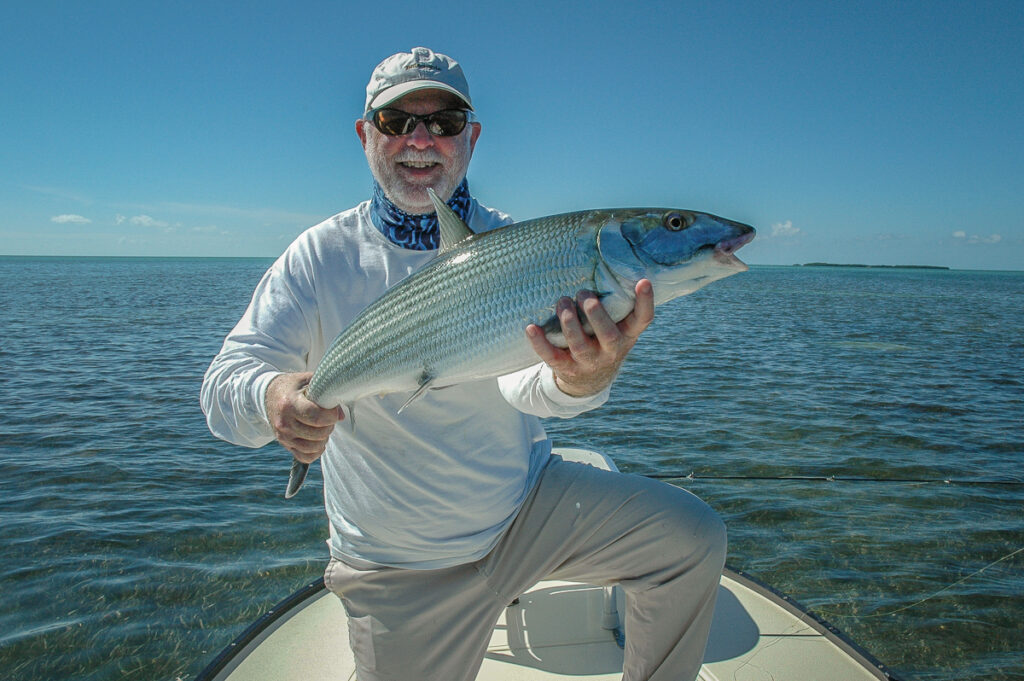Email Cell -305.393.1245
HOME » Bonefish
 Islamorada and the Florida Keys are known for big bonefish; the average size of bonefish in South Florida and the Florida Keys ranges from four to seven pounds and ten to twelve-pound bonefish are not uncommon. Many large bonefish, weighing from thirteen to fourteen pounds, have rarely raised an eyebrow over the years, and can still be found year-round.
Islamorada and the Florida Keys are known for big bonefish; the average size of bonefish in South Florida and the Florida Keys ranges from four to seven pounds and ten to twelve-pound bonefish are not uncommon. Many large bonefish, weighing from thirteen to fourteen pounds, have rarely raised an eyebrow over the years, and can still be found year-round.
I sightfish for bonefish on the Bay and Oceanside, including flats and banks that extend deep into Florida Bay. Most folks don’t associate bonefish with the Everglades National Park, but the fact is that a large portion of our prime bonefish habitat lies within the Park’s boundaries.
Bonefish live throughout the Florida Keys year-round, but fishing can be weather-dependent in the fall and winter, during or after a cold front. Fall and early spring are generally best for larger bonefish, and late spring through the summer months are great for numbers of smaller school fish.
Sight fishing for bonefish is a great way to hone your casting skills for any fish species on a fly or spinning tackle. There can be a fine line between a perfect presentation and one that either scares the fish or one that the fish doesn’t ever see. Most of the time, the ideal presentation will be rewarded with a bite when using live bait—but not always on fly; a follow or some kind of positive reaction short of a bite can be considered a moral victory!
The cold fronts of 2010 and 2011 caused a dramatic drop in water temperatures across South Florida and the Keys, resulting in severe game fish die-offs. Bonefish, highly sensitive to cold, were particularly affected in shallow flats, leading to significant population declines. This loss disrupted our local ecosystem and dealt a blow to the region’s commercial (guided fishing) and recreational fishing, which heavily depends on bonefishing. In response, conservation efforts intensified, focusing on habitat restoration and research to support the species’ recovery. While the population has shown improvement, these events highlighted the vulnerability of bonefish to extreme weather.
For bonefishing in the Florida Keys, an 8 to 9-weight fly rod paired with a floating or clear floating line is ideal. A high-quality fly reel with a smooth, reliable drag system is essential.
Tapered fluorocarbon leaders between 9 and 14 feet, with a tippet from 12 to 15-pound test, provide the right balance of stealth and strength.
Choosing the right bonefish fly is as much an art as a science, with opinions varying widely among guides and anglers. The most effective patterns mimic the natural prey found on the flats, including shrimp, crabs, toadfish, and other small baitfish. Each design is intended to trigger a bonefish’s predatory instincts through subtle movement, a lifelike profile, or the way it settles on the bottom.
Since bonefish feed at different depths, carrying a range of weighted flies is essential. Lighter flies are ideal for shallow water, where a delicate landing is necessary to avoid spooking fish. Heavier flies, often tied with lead or bead-chain eyes, sink more quickly and are better suited for deeper water or stronger currents.
Color selection is just as important as weight and pattern. A well-matched fly blends naturally with the surrounding bottom, making it less likely to be rejected. In areas with light sand, neutral and pale shades tend to be more effective, while darker colors work better over grass or muddy flats.
Presentation plays a critical role, as bonefish have sharp eyesight and react instantly to unnatural movement, so a properly placed fly with a realistic approach is often the key to success. Understanding how different flies behave in various conditions and adjusting the retrieve accordingly can make all the difference when sight fishing on the flats.
A 7-foot moderate to fast-action spinning rod is well-suited for casting live bait or artificial lures to bonefish. Pair it with a high-quality spinning reel featuring a smooth, dependable drag system. Spool it with 10-pound monofilament or braid in #2 or #4 diameter (12–15 lb. test) for optimal performance.
Everglades National Park began collecting entrance fees for all park visitors on January 10, 2019 – including anglers with licensed fishing guides, Effective January 2025, 7-day passes will be $35 per person. You may also purchase an annual Everglades National Park pass for $70. Children aged 15 and under are always admitted free.